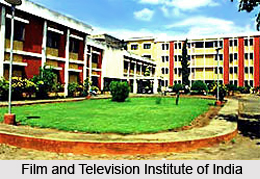 Film and Television Institute of India (FTII) was set up in the year 1960 with the intent of imparting training in film making and television programme production. The FTII is an autonomous body under the Ministry of Information and Broadcasting of the Government of India. Its policies are determined by a Governing Council. The Appointment Committee of Cabinet (ACC) of the Government of India appoints the Director of the Institute. Today the FTII is considered as a Center of Excellence not only in India but also in Asia and Europe. Films made by the students of the Institute are entered in festivals both in India and abroad. Many of them have won National and International awards. The FTII is a member of CILECT, an international association of film schools
Film and Television Institute of India (FTII) was set up in the year 1960 with the intent of imparting training in film making and television programme production. The FTII is an autonomous body under the Ministry of Information and Broadcasting of the Government of India. Its policies are determined by a Governing Council. The Appointment Committee of Cabinet (ACC) of the Government of India appoints the Director of the Institute. Today the FTII is considered as a Center of Excellence not only in India but also in Asia and Europe. Films made by the students of the Institute are entered in festivals both in India and abroad. Many of them have won National and International awards. The FTII is a member of CILECT, an international association of film schools
During 1974, the scope of the Institute was enlarged to include the then rapidly developing field of television. The Television Wing, earlier located at the Mandi House, New Delhi, shifted to the Institute campus at Pune during the early seventies so as to bring together training in film and television under a common roof, thereby justifying the name of the Institute - the Film and Television Institute of India. This wing of the institute has been primarily concerned with conducting in-service training to personnel from Doordarshan.

Among the courses offered by the FTII are courses in film and television Direction, Acting, Cinematography, Art Direction and Production Design, Editing, Animation and Computer Graphics, Sound Recording & Sound Design, Feature Film Screenplay Writing. Medium of instruction for all academic programmes at FTII is English.
Infrastructure at FTII
The FTII is well-equipped with the most up-to-date equipment. Students initially work with the low-end equipment and gradually get to use the advanced equipment through demonstrations and individual practicals. There are two Film studio floors - Studio I & II - of dimensions 175 ft X 80 ft and 97 ft X 51 ft respectively. There are 4 Nos. of 35 mm Cameras and 4 Nos. of 16 mm cameras for film shooting and the video cameras from the low-end to the high-end digital models. The HMI types of lights are now routinely available to the students. Similarly Film editing facilities include and array of Moviolas and Steenboks and for video editing the facilities available are from the low-end to high-end. At another level, there are the nonlinear editing systems. In the Sound department the Institute has sufficient number of Nagras, an exclusive Sound studio dubbing with rock-n-roll projection facilities and it has recently acquired the Harrison audio mixing console too.
On the television side, there are two Television studios - Studio I & II - of dimensions 60 ft X 40 ft X 22 ft and 50 ft X 40 ft X 22 ft fitted with the state-of-the art facilities. The studios are fitted with motorized lighting systems, computer-driven martin special effect facilities, follow Spots etc. One studio is fitted with digital broadcast quality studio camera chain. There are multilingual character generators (CGs) and computer-driven tele-prompt facilities among the accessories. Ultimate chrome-keyer is another pride possession of the Television wing. The Institute has a full-fledged Graphics Department ready to offer inputs and the department has acquired O2 Silicon Graphics facility for use in its working.
The Institute has a spacious book library with a substantial collection of books related to film, television, theatre, fine arts, literature etc. The Institute also subscribes to a number of technical and general periodicals published in the country and abroad. The Institute has a film and a video library with a good collection of films and videos from all over the world.






